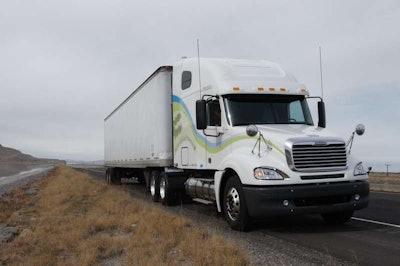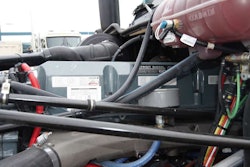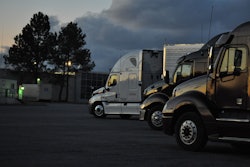 The Series 60 Detroit Diesel engine used in the test drive. The engine was refurbished and retrofitted with a bi-fuel natural gas kit from APG and Wheeltime before being dropped in a Freightliner Columbia glider.
The Series 60 Detroit Diesel engine used in the test drive. The engine was refurbished and retrofitted with a bi-fuel natural gas kit from APG and Wheeltime before being dropped in a Freightliner Columbia glider.A road test and first-hand accounts of experience with natural gas retrofit fuel systems and glider kits reveal interesting possibilities for cost-minded truck fleets.
The first part of my test drive was west on I-80 out of Salt Lake City, on the level desert run that leads to the Bonneville Salt Flats. The goal then had been flat ground and little traffic to give me a feel for the truck. But now, we’d doubled back and were climbing the Wasatch Mountains east of the city on I-215 leading to I-80 East toward Park City.
Here, I’d get a chance to pull see some serious mountain grades and see for myself if a dual-fuel, diesel-ignited natural gas truck engine was up to hauling 44,000 pounds in this demanding terrain.
As we started up the first grade, for reasons known only to Utah traffic engineers, the road suddenly began a series of winding S-turns at the same time as construction took a couple of lane options off the table.
The truck was pulling well, but I grabbed another gear just to be on the safe side. As I did, we emerged from a particularly sharp and narrow curve to behold an industrial-grade cargo cart sitting directly in the lane in front of me. This was no Dollar General shopping cart; but rather a full-blown, orange-painted steel cart with cast-iron wheels that had obviously fallen off a truck just up ahead. Hit it and your day was over.
Video log: Fueling, driving natural gas glider kit
Acting quickly, I eased my rig over to the side of the highway, watching out for four-wheelers darting and swerving all around me. After a couple of dicey seconds riding the median, I eased the truck back onto the highway and continued my climb.
I mention the incident with the cargo cart not because there was anything special about how I dealt with the situation: It was an unpleasant few seconds during the drive – but nothing special in the world of truck driving. Rather, the cart was significant because it was the most remarkable thing that occurred during my test drive of the Freightliner Columbia I was driving that day. And that’s not a slam against the truck. But rather a vindication that this rig, a glider kit fitted with a refurbished diesel engine that itself was retrofitted with an American Power Group (APG) natural gas fuel system, had performed exactly as the folks at APG, the Wheel Time Group and Smith Power, the manufacturer of the truck, had assured me it would.
What lies beneath
Last year, I reported on the partnership founded between a cabal of glider kit builders, sales and support provider Wheel Time, natural-gas supplier Blu and APG to introduce the concept of natural gas glider kits to the North American trucking industry. The concept is simple: Fleets wishing to find an affordable way to get into the natural gas fuel game can spec glider kits with retrofit fuel systems and save as much as $40,000 on the vehicle compared to purchasing a new, dedicated natural gas truck. A further enticement for fleets, the argument goes, is that fleets can spec older, pre-EPA emissions (EGR) engines to power these trucks and enjoy more reliable power and serviceability in the bargain.
 The Freightliner Cascadia driven in the drive test.
The Freightliner Cascadia driven in the drive test.My test rig on that blustery Utah morning was a perfect example. The rig was a gleaming white 2014 Freightliner Columbia daycab truck. On the outside, even seasoned industry veterans would be unable to tell that this truck is anything other than a brand-new Freightliner ready to go to work.
Climbing up into the cab, that reaction is further reinforced: The interior still had a factory-fresh smell with full, modern instrumentation and gauges, mirrors and ergonomics. Because the truck had been spec’d as a regional-haul daycab, its interior appointments were pretty basic. But if you wanted to upgrade the interior with the latest Daimler diagnostic and telematics systems, it wouldn’t be a problem at all.
It was underneath the hood and cab where the real differences this tractor offered were to be found.
Pulling the hood forward revealed not the new, SCR-equipped DD12 you could reasonably expect to see sitting there. Instead I was greeted with a concrete-gray, 1996-vintage Series 60 Detroit Diesel engine.
Basically, glider kits take advantage of a quirky little loophole in truck manufacturing laws that allow fleets to purchase a truck with a brand-new cab and chassis, fitted with a recycled or refurbished drivetrain. The additional twist, thrown into the mix by APG, Wheeltime and their partners is that their rebuilt powertrains receive the further addition of a natural gas fuel and tank system.
The system manages the flow of the two fuels to the engine, using diesel both as the ignition source in the combustion chamber and as a power boost in situations demanding higher torque from the engine. So, when the truck is just getting rolling or climbing a steep mountain grade, the system supplies larger amounts of diesel to the engine (up to 50 percent of the fuel supplied, depending on road and terrain conditions) and then dials that ratio back as engine load demands decrease.
[youtube oXzTaYL7w2I nolink]
So, on my flat run heading west, the engine was using a minimum of diesel – only a little shot to initiate combustion – while the cheaper natural gas kept the wheels turning. Later, in the mountains, the system delivered a significantly higher percentage of diesel to the combustion mix to make sure I had plenty of power on hand to deal with the road I was on.
It’s a slick system that works surprisingly well. On the road, the truck handles and drives exactly as one expects: it is, after all, a brand-new truck. The only indications that something unusual is going are an electronic fuel system monitor on the dash, which tells the driver what the diesel to natural gas fuel ratio is.
The second indication is the noise level in the cab. Although the truck is new, remember that it has a 20-year engine under the hood. And although that engine is also brand-new, for all practical purposes, and has received several technological upgrades in the course of the refurbishing process it went through, it is still a noticeably louder engine that new ones that come out of the factories today. So some more pronounced drivetrain noise is to be expected.
On the other hand, if you’re a fan of older engines like the Series 60, it’s a good bet that you’re more than happy to trade off a little more ambient cab noise for the chance to run those engines again.
(To be fair, the work engine makers have done over the reduce noise levels emitted by heavy-duty diesel engines is unprecedented and largely goes unsung and unrecognized by the general public and even many fleets and drivers. Additionally, it should be noted that drivetrain noise decreases somewhat as the amount of diesel fuel being delivered to the engine falls off. So the truck is noticeably quieter when running predominantly on natural gas.)
Most important of all, of course, is the performance of the fuel system in real-world driving conditions; which was why my hosts in Salt Lake were so eager for me to drive the truck in the mountains to the east of the city.
And, again, as my earlier cart-in-the-road story testified, the dual-fuel system delivered in spades. The glider kit pulled as well as any truck on the highway. We were loaded with about 44,000 pounds in the box and had no problem dealing with any of the grades – up to 6 in percent in some areas – that we encountered. This is a system that works on behalf of fleets and drivers to get the job done.
See Part 2 of this series Monday.









